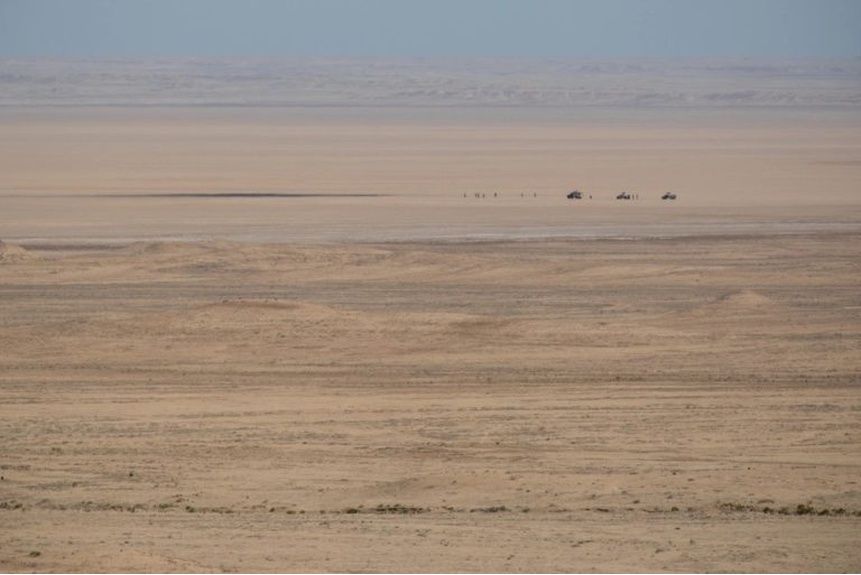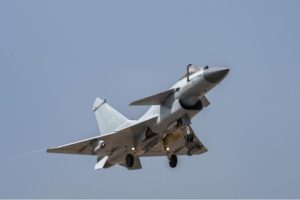
Iran Repositions Its Proxies in Syria as Russia Turns Focus to Ukraine
Local media reports indicate that Iran is “repositioning” in Syria, perhaps seeking to take advantage of the Russian military’s focus on Ukraine. A late February report by Syria-focused Turkish think tank

Syrian Democratic Force soldiers conduct a patrol during a joint operation with U.S. Army Soldiers in Syria on May 8, 2021.
“…Iran will not miss this opportunity to consolidate and expand its influence in various sectors, taking advantage of the regime’s need for assistance and support…”
Local media reports indicate that Iran is “repositioning” in Syria, perhaps seeking to take advantage of the Russian military’s focus on Ukraine. A late February report by Syria-focused Turkish think tank Jusoor Center for Studies speculates that Russia’s focus on Ukraine may detract from its involvement in Syria, “and Iran will not miss this opportunity to consolidate and expand its influence in various sectors.” The report mentions several signs of Iran’s repositioning in Syria, including increased activities and weapons transfers by Iran-backed militias in regime-controlled areas of the Syrian desert and the Middle Euphrates River Valley, near the border with Iraq. Tensions were rising between Russian and Iranian proxies in Deir Ezzor Province during the build up to Russia’s invasion of Ukraine, according to the accompanying excerpt from the Syrian opposition media source Syrian Observatory for Human Rights. Russian airstrikes on ISIS positions in the desert have declined substantially since the start of the war in Ukraine, even as the group has ramped up its attacks in the Syrian desert, according to a report from the pro-Syrian opposition Lebanese news website al-Modon. The Quds Brigade, Russia’s key ally in anti-ISIS efforts in the Syrian desert, withdrew precipitously to Damascus. Meanwhile, local media reports claim several Iraqi militias have returned to Iraq and Iranian proxies in the Fatemiyoun Brigade have redeployed in the area. The logic behind these movements remains murky, but the accompanying excerpt from the Saudi daily al-Sharq al-Awsat speculates that they relate to strengthening supply lines and transit corridors between Iran’s proxies in Iraq and Syria.
Source:
“6 مؤشرات على إعادة تموضع إيران في سورية
(Six indicators that Iran is repositioning in Syria),” Jusoor Center for Studies (Turkey-based think tank focused on Syria), 4 March 2022. https://tinyurl.com/2p8tnvv4
Since the beginning of 2022, Iran has begun to undertake a series of political, military, economic and security activities in coordination with the Syrian regime, which indicates its repositioning in Syria…
… the continuation of conflict in Ukraine may lead to a decline in Russia’s interest in Syria. Iran will not miss this opportunity to consolidate and expand its influence in various sectors, taking advantage of the regime’s need for assistance and support…
Source:
“تصاعد ملحوظ في الحرب الباردة بين الجانبين الروسي والإيراني في محاولة لكسب ود أهالي القرى السبع شرقي الفرات
(Notable Escalation in the Cold War between Russia and Iran in an attempt to gain allegiance from the ‘Seven Villages’ east of the Euphrates),” Syrian Observatory for Human Rights (Syrian opposition media source), https://tinyurl.com/2p85pm2x, 16 February 2022.
Recently, the competition between Russia and Iran has escalated in the countryside of Deir Ezzor governorate, specifically in the so-called “seven villages” under the influence of the Iranians and the regime east of the Euphrates, and the corresponding areas on the western bank of the river…
Source:
“إيران تتمدد في سوريا..إثر تراجع النشاط الروسي
(Iran expands in Syria… following decline in Russian activities),” al-Modon (pro-Syrian Lebanese news website), 12 March 2022. https://tinyurl.com/2p8v8v9y
Russian military activities throughout the Syrian territory have declined as the Russian attack on Ukraine enters its third week. At the same time, Iranian militias are sending military reinforcements to the city of Palmyra and its surroundings.
…“the Russian aerial bombardment on the Syrian desert is half of what it was before the war on Ukraine”…
On Friday, the Palestinian “Quds Brigade” militia withdrew from the city of Palmyra, located in the eastern countryside of Homs. Militia members left the city heading towards the governorate of Damascus. The motives for this withdrawal remain unknown and it is unclear whether they will return later. According to the sources of the Syrian Observatory, the Quds Brigade’s withdrawal came without prior warning or coordination with the regime’s security services located in Palmyra and its surroundings.
Source:
“مئات من ميليشيات إيران يغادرون سوريا إلى العراق
(Hundreds of Iranian miliitas leave Syria for Iraq),” al-Sharq al-Awsat (influential Saudi daily), 7 March 2022. https://tinyurl.com/mrdd5r2m
Syrian activists reported that the Iranian Revolutionary Guard began withdrawing a large number of militia members of the Fatemiyoun Brigade (Afghani) and Iraqi (Shiite) militias from military sites in the areas of Palmyra and Sukhna, east of Homs, into Iraqi territory, through unauthorized crossings. Other fighters from the (Afghan Fatemiyoun) Brigade were deployed to new camps east of Palmyra. The sites in Homs countryside and a number of military vehicles and equipment were handed over to the Iranian Revolutionary Guards. The development was described by activists in the region as “remarkable,” at a time when (ISIS) launched repeated attacks against regime forces and Iranian militias in the Homs desert and Deir Ezzor, incurring losses in life and equipment.
Image Information:
Image: Syrian Democratic Force soldiers conduct a patrol during a joint operation with U.S. Army Soldiers in Syria on May 8, 2021.
Source: Spc. Isaiah J Scott, https://www.dvidshub.net/image/6705061/sdf-conducts-patrol-syria
Attribution: Public Domain
Distribution A: Approved for public release
Categories:
Tags:
Related Products
Chinese Military Exercises Highlight Improvements in Joint Operations






